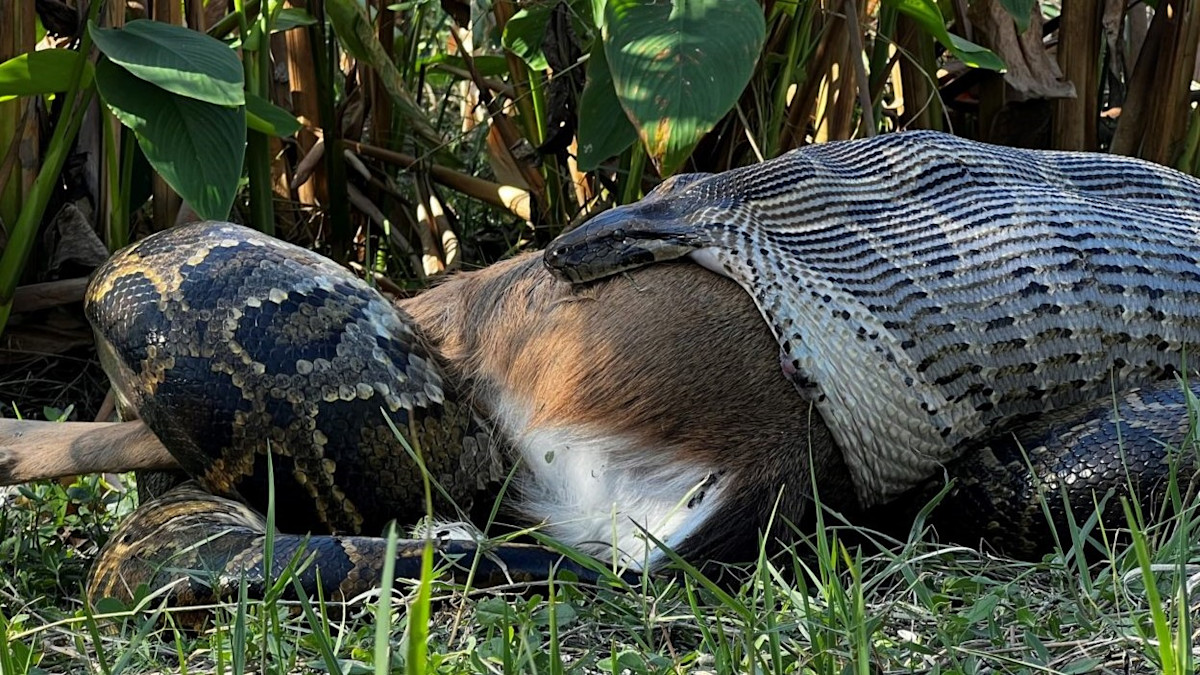
South Florida deer hunters will tell you that Burmese pythons have done a number on the local whitetail population. However, it’s been unclear whether these snakes, like coyotes, are preying mostly on fawns or if they can fit a full-grown deer down their gullets.
Now, we have photographic evidence that not even adult deer are safe from these giant reptiles.
In a study published last month in the journal “Reptiles and Amphibians,” researchers published the first-ever photos of a Burmese python devouring an adult whitetail deer.

Researchers who took the photos say the snake used its tail to grab the deer’s back legs and anchor it to the ground as it maneuvered its mouth around the deer. They found the snake when it had already consumed the front half of the unfortunate ungulate, and it took another 21 minutes to get the back half down its gullet.
“Watching an invasive apex predator swallow a full-sized deer in front of you is something that you will never forget. The impact the Burmese python is having on native wildlife cannot be denied. This is a wildlife issue of our time for the Greater Everglades ecosystem,” said Ian Bartoszek of the Conservancy of Southwest Florida, one of the organizations involved in the study.
They waited until the snake had consumed the deer, then they held it down and forced it to regurgitate its meal. They found that the whitetail buck weighed about 77 pounds, and the snake weighed about 115.
Knowing the maximum size of animal on which these snakes are capable of preying helps us identify the best way to manage both these snakes and other species, researchers say. The study’s authors considered this snake alongside two other Burmese pythons and found that all three had a “maximal gape diameter” (i.e., how wide the snakes could open their mouths) of 26 cm. This is significant because, according to the researchers, the previously reported maximal value of these snakes was 22 cm.
“Besides the large absolute size of the deer that was eaten being impressive, our anatomical measurements indicate this deer was very near the size limit on the prey that could be consumed by this snake. Hence, these snakes resemble over achievers by sometimes testing the limits of what their anatomy allows rather than being slackers that eat only ‘snack size’ prey,” said Bruce Jayne, the study’s lead author.
The researchers admit that they don’t know how often these snakes take down an adult deer. It takes a pretty large snake to swallow a 77-pound buck, and even if a snake is capable of doing this, it might not make the attempt very often.
“Snakes simply might refuse to attack prey above a given size that is well within what their gape could accommodate. Furthermore, even if snakes attack prey of sizes near their maximal gape, such large prey could be too difficult to subdue and swallow,” they write.
Still, knowing the snakes don’t just go after fawns means adult deer need protection as well. This particular snake went after a deer that was 93% of its maximal gape, which means it was either an unusually ambitious reptile or south Florida whitetail deer are in more trouble than previously thought.
In the past 12 years, the Conservancy’s Burmese Python Research and Removal team has removed 770 adult pythons. If each of these snakes ate only one deer as big as they could swallow, Jayne estimates that would be a total of more than 13,000 pounds of deer.
Feature Image: Ian Bartoszek, Conservancy of Southwest Florida.






